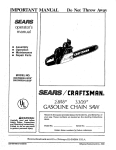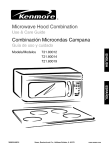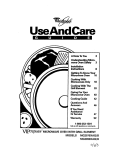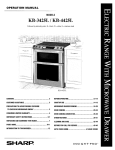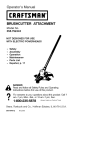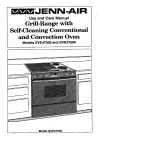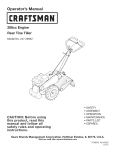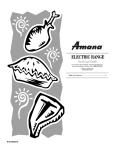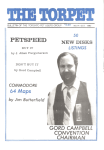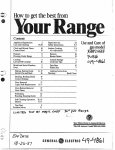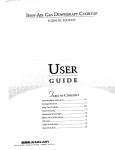Download Maytag MMVS156AA Microwave Oven User Manual
Transcript
T Ove Oven e Owner's Manual Covering Installer: Model MMVS156AA Please leave this manual with this appliance. Consumer: Please read and keep this manual for future reference. Keep sales receipt and/or cancelled check as proof of purchase. Model Number Serial Number Date of Purchase Contents Important Safety Instructions ................................................................ 2-5 Features ................................................................................................ 6-7 Operation ............................................................................................ In our continuing effort to improve the quality and performance of our appliances, it may be necessary to make changes to the appliance without revising this guide. 8-17 Cooking ............................................................................................. 18-22 Maintenance ...................................................................................... 23-24 Recommended Utensils ......................................................................... 25 Troubleshooting ...................................................................................... 26 Questions and Answers .......................................................................... 27 Warranty ................................................................................................. 28 If you have questions, write us (include your model number and phone number) or call: Maytag Appliances Sales Company Attn: CAIR® Center P.O. Box 2370 Cleveland, TN 37320-2370 1-800-688-9900 U.S.A. 1-800-688-2002 Canada 1-800-688-2080 (U.S.A. TTY for hearing or speech impaired) (Mon.-Fri., 8 am - 8 pm Eastern Time) Intemet: http ://www.maytag.com A/03/02 Electric Microwave Keep instructions for future reference. Be sure manual stays with oven. °2002 Maytag Appliance Sales Co. Part No.8112P191-60 3828W5A2399 What You Need to Know About Safety instructions Warning and Important Safety In= structions appearing in this manual are not meant to cover all possible conditions and situations that may occur. Common sense, caution, and care must be exercised when installing, maintaining, or operating microwave. Always contact your dealer, distribu= tor, service agent, or manufacturer about problems or conditions you do not understand. Recognize I DANGER-- Safety Symbols, Words, _ DA.GER i CAUTION-- 1 immediate hazards which WiLL result in severe personal injury or death. i WARNING-- Labens 1 Hazards or unsafe practices which COULD result in severe per= sonal injury or death. _,cAuTuo. ] Hazards or unsafe practices which COULD result in minor per= sonal injury. i CAUTION When using electrical appliances, basic safety precautions should be followed to reduce the risk of burns, electric shock, fire, or injury to persons or exposure to excessive microwave energy. 1. READ all instructions before using oven. 11. DO NOT heat baby bottles in oven. 2. READ AND FOLLOW the specific "PRECAUTIONS TO AVOID POSSIBLE EXPOSURE TO EXCESSiVE MICROWAVE ENERGY" on this page. 12. DO NOT operate this oven if it has a damaged cord or plug, if it is not working properly, or if it has been damaged or dropped. 3. This oven MUST BE GROUNDED. Connect only to properly GROUNDED outlet. See installation instructions. 4. Install or locate this oven ONLY in accordance with the installation instructions in this manual. 13. This oven, including power cord, must be serviced ONLY by qualified service personnel. Special tools are required to service oven. Contact nearest authorized service facility for examination, repair, or adjustment. 5. Some products such as whole eggs and sealed containers--for example, closed glass jars--are able to explode and SHOULD NOT be HEATED in this oven. 14. DO NOT cover or block filter or other openings on 6. Use this oven ONLY for its intended use as described in this manual. Do not use corrosive chemicals or vapors in this oven. This type of oven is specifically designed to heat, cook, or dry food. It is not designed for industrial or laboratory use. 7. As with any appliance, CLOSE SUPERVISION is necessary when used by CHILDREN or INFIRM PERSONS. 8. See door cleaning instructions in the Care and Cleaning section of manual on page 23. 9. Baby food jars shall be open when heated and contents stirred or shaken before consumption, in order to avoid burns. 10. DO NOT use this oven for commercial purposes. It is made for household use only. oven. 15. DO NOT store this oven outdoors. DO NOT use this product near water = for example, near a kitchen sink, in a wet basement, near a swimming pool or similar locations. 16. DO NOT immerse cord or plug in water. 17. Keep cord AWAY from HEATED surfaces. 18. DO NOT let cord hang over edge of table or counter. 19. Clean the ventilating hood frequently. 20. Do not allow grease to accumulate on the hood or filters. 21. Use care when cleaning the ventilating hood filters. Corrosive cleaning agents such as lye-based oven cleaners may damage the filters. 22. When flaming foods under the hood, turn the fan on. 23. Suitable for use above both gas and electric cooking equipment 36 inches or less wide. PRECAUTIONS TO AVOID POSSIBLE EXPOSURE TO EXCESSIVE MICROWAVE ENERGY A. DO NOT attempt to operate this oven with the door open since open door operation can result in harmful exposure to microwave energy. It is important not to defeat or tamper with the safety interlocks. B. DO NOT place any object between the oven front face and the door to allow soil or cleaner residue to accumulate on sealing surfaces. C. DO NOT operate the oven if it is damaged. It is particularly important that oven door close properly and that there is no damage to: 1. door (bent), 2. hinges and latches (broken or loosened), 3. door seals and sealing surfaces. D. Oven should not be adjusted or repaired by anyone except properly qualified service personnel. SAVE THESE INSTRUCTIONS Recognize I this symbol WARNING I To avoid risk of fire in the oven cavity: a. DO NOT overcook food. Carefully attend oven when paper, plastic, or other combustible materials are placed inside the oven to facilitate cooking. as a SAFETY message I CAUTION To avoid personal injury observe the following: d. DO NOT use the cavity for storage. DO NOT leave paper products, cooking utensils, or food in the cavity when not in use. I : WARNING . 3. Pierce skin of potatoes, tomatoes, and similar foods before cooking with microwave energy. When skin is pierced, steam escapes evenly. . I THE LIQUID. To reduce the risk of injury to persons: 1. Do not overheat the liquid. 2. Stir the liquid both before and halfway through heating it. containers with nar- 4. After heating, allow the container to stand in the microwave oven for a short time before removing the container. 5. Use extreme care when inserting a spoon or other utensil into the container. damage, Do not cook or reheat eggs in shell or with an unbroken yolk using microwave energy. Pressure may build up and erupt. Pierce yolk with fork or knife before cooking. 4. Do not operate oven without oven cavity. Liquids such as water, coffee, or tea are able to be overheated beyond the boiling point without appearing to be boiling due to surface tension of the liquid. Visible bubbling or boiling when the container is removed from the microwave oven is not always present. THIS COULD RESULT IN VERY HOT LIQUIDS SUDDENLY BOILING OVER WHEN A SPOON OR OTHER UTENSIL IS INSERTED INTO 3. Do not use straight-sided row necks. or property 1. Do not deep fat fry in oven. Fat could overheat and be hazardous to handle. b. Remove wire twist-ties from paper or plastic bags before placing bag in oven. c. If materials inside the oven ignite, keep oven door CLOSED, turn oven off and disconnect the power cord, or shut off power at the fuse or circuit breaker panel. I load or food in Use only popcorn in packages designed and labeled for microwave use. Popping time varies depending on oven wattage. Do not continue to heat after popping has stopped. Popcorn will scorch or burn. Do not leave oven unattended. 6. Do not use regular cooking thermometers in oven. Most cooking thermometers contain mercury and may cause an electrical arc, malfunction, or damage to oven. 7. Do not use metal utensils in oven. 8. Never use paper, plastic, or other combustible materials that are not intended for cooking. 9. When cooking with paper, plastic, or other combustible materials, follow manufacturer's recommendations on product use. 10. Do not use paper towels which contain nylon or other synthetic fibers. Heated synthetics could melt and cause paper to ignite. 11. Do not heat sealed containers or plastic bags in oven. Food or liquid could expand quickly and cause container or bag to break. Pierce or open container or bag before cooking. 12. To avoid pacemaker malfunction, consult physician or pacemaker manufacturer about effects of microwave energy on pacemaker. SAVE THESE INSTRUCTIONS FEDERAL COMMUNICATIONS COMMiSSiON RADIO FREQUENCY iNTERFERENCE STATEMENT ( U.S.A. ONLY) This equipment generates and uses ISM frequency energy and if not installed and used properly, that is in strict accordance with the manufacturer's instructions, may cause interference to radio and television reception, tt has been type tested and found to comply with limits for ISM Equipment pursuant to part 18 of FCC Rules, which are designed to provide reasonable protection against such interference in a residential installation. However, there is no guarantee that interference will not occur in a particular installation. If this equipment does cause interference to radio or television reception, which can be determined by turning the equipment off and on, the user is encouraged to try to correct the interference by one or more of the following: • Reorient the receiving antenna of the radio or television. • Relocate the microwave oven with respect to the receiver. • Move the microwave oven away from the receiver. • Plug the microwave oven into a different outlet so that the microwave oven and the receiver are on different branch circuits. The manufacturer is not responsible for any radio or TV interference caused by unauthorized this microwave oven. It is the responsibility of the user to correct such interference. Grounding I WARNING I To avoid risk of electrical shock or death, this oven must be grounded and plug must not be altered. Instructions Oven MUST be grounded. Grounding reduces risk of electric shock by providing an escape wire for the electric current if an electrical short occurs. This oven is equipped with a cord having a grounding wire with a grounding plug. The plug must be plugged into an outlet that is properly installed and grounded. Consult a qualified electrician or servicer if grounding instructions are not completely understood, or if doubt exists as to whether the oven is modification to Do not use an extension cord. If the product power cord is too short, have a qualified electrician install a three-slot receptacle. This oven should be plugged into a separate 60 hertz circuit with the electrical rating as shown in specifications table. When the combination oven is on a circuit with other equipment, an increase in cooking times may be required and fuses can be blown. Microwave operates on standard household current, 110-120V. properly grounded. SAVE THESE INSTRUCTIONS Features OVEN SPECIFICATIONS Model and Serial Number Plate Window with Metal Shield Door Handle Vent Grille Glass Turntable 120 VAC, 60 Hz Input Power 1,500 W Cooking Power 1,000 W (IEC 60705 Standard) Frequency 2,450 MHz Rated Current 13 A Outer Dimensions (WxHxD) 29_-%6 '' x 16_6" 15 %" Cavity Volume 1.5 Cu. Ft. Net Weight 52 Ibs. Cooking Guide Metal Rack Control Panel Door Safety Lock System Cooktop/Countertop Grease Power Supply Light Filter FEATURES NOTE: Styling and features vary by model. @ . DISPLAY: The Display includes a clock and indicators to tell you time of day, cooking time settings and cooking functions selected. . POPCORN: Touch this pad when popping popcorn in your microwave oven. The oven's sensor will tell the oven how ® ® ® ,@ ................................ @ @ @ long to cook depending on the amount of humidity it detects from the popcorn. See page 12 for more information. . ® @ @ @ }!I}li @ POTATO: Touch this pad to cook potatoes. The oven's sensor will tell the oven how long to cook depending on the amount of humidity it detects from the potato. See page 13 for more information. @ @ @ @ @ BAKED . PlZZA SLICE: Touch this pad to reheat pizza without selecting cooking times and power levels. See page 12 for more information. 5. COOK:Touchthis padto cook 11. AUTODEFROST: Meat,poultry, frozen entree,casserole,and fish. Touchthis pad to select rice.Theoven'ssensorwill tell foodtype and defrostfood by the oven how long to cook weight.See page13 for more information. dependingon the amountof humiditycomingfromthe food. 12. TIMEDEFROST: Touchthispad Seepage13for moreinformato defrost most other frozen tion. foods.See page 15 for more information. 6. REHEAT:Touch this pad to reheatcasserole,dinnerplate, 13. ADD30SEC.:Touch thispadto and soup/sauce.The oven's set and start quicklyat 100% sensorwill tell the oven how power level. See page 9 for longto cookdependingon the moreinformation. amountof humiditycomingfrom thefood.Seepage13formore 14. NUMBER:Touchnumberpads information. to enter cookingtime, power level,quantities,or weights. 7. VEGETABLE: Touchthispadto reheatvegetables.The oven's 15. POWERLEVEL:Touchthispad sensorwill tell the oven how toselecta cookingpowerlevel. longto cookdependingon the 16. CUSTOMPROGRAMS: Touch amountof humidityit detects thispadto seta cookingtime. fromthe vegetables.Seepage 13formoreinformation. 17. HOLDWARM:Touchthispadto keephot,cookedfoodswarmin 8. CUSTOMRECIPE: Touchthis yourmicrowaveovenfor up to pad to recall one cooking 99 minutes99 seconds.See instruction previously propage9 formoreinformation. grammed into memory. See page10formoreinformation. 18. STOP/CLEAR: Touchthis pad to stop the ovenor to clearall 9. MORE:Touchthis padto add entries. ten secondsof cookingtime each time you press it. See 19. START:Touchthispadtostarta page10formoreinformation. function.If you openthe door afterovenbeginstocook,touch 10. LESS:Touchthis padto subSTARTagain. tract ten secondsof cooking timeeachtimeyoupressit.See page10formoreinformation. 20. OPTIONS: Touchthis padto changetheoven'sdefault settingsforsound,clock,display speedanddefrostweight.See page8 formoreinformation. 21. HELP:Touchthis padto learn howto useeachovenfunction. See page8 for moreinformation. 22. TURNTABLEON/OFF:Touch thispadtoturnofftheturntable. OFFwill appearin the display. See page8 for moreinformation. NOTE:Thisoptionis notavailable in sensorcookanddefrost modes. 23. CLOCK:Touchthispadto enter thetimeof day.Seepage8 for moreinformation. 24. LIGHTTIMER:Touchthis pad tosetthelighttimer.Seepage9 formoreinformation. 25. KITCHENTIMER: Touchthis padtosetthekitchentimer.See page8 formoreinformation. 26. FANHI LOWOFF: Touchthis padtoturnthefanonor off.See page8 formoreinformation. 27. LIGHTHILOWOFF:Touchthis padtoturnonthecooktop/countertoplight.Seepage9 formore information. Operation LEARN ABOUT YOUR MICROWAVE OVEN This section discusses the concepts behind microwave cooking and introduces you to the basics you need to know to operate your microwave oven. Please read this information before use. i KITCHEN TIMER FAN HI LOW OFF You can use your microwave oven as a timer. Use the Timer for timing up to 99 minutes 99 seconds. The FAN moves steam and other vapors from the cooking surface. The vent will operate at low speed whenever the oven is on. Example: To time 3 minutes 1. Touch KITCHEN TIMER pad. 0 a,CAUTIONj 0 To avoid risk of personal injury or property damage, do not run oven empty. To avoid risk of personal injury or property damage, do not use stoneware, aluminum foil, metal utensils, or metal trimmed utensils in the oven. HELP The HELP pad displays feature information and helpful hints. Press HELP, then select a key pad. Example: To learn about POPCORN 3. Touch START pad. When the time is over, you will hear seven beeps and END will display. OPTIONS CLOCK ....... C/< I 1. Touch CLOCK pad. (Press once for AM, twice for PM) _°_ 0 0 <ii1<_ ::F< 2. Enter the time by using the number key pad. 3. Touch CLOCK pad. If the temperature gets too hot around the microwave oven, the fan in the vent hood will automatically turn on at the HIGH setting to cool the oven. It may stay on up to an hour. When this occurs, the vent cannot be turned off. TURNTABLE See following chart for more information. No, Function No. Result 1 Beep ON/ OFF control 1 Sound ON 2 Sound OFF 2 Clock display control 1 Clock ON 2 Clock OFF 3 Display 1 Slow speed 2 Normal speed 3 Fast speed Defrost weight mode selected 1 Lbs. 2 Kg. This oven includes a 24-hour clock. Example: To set 8:00 AM NOTE: You can change the default values for beep sound, clock, display speed and defrost weight. 1. Touch HELP pad. 2. Touch POPCORN pad. 2. Enter the time by using the number key pad. To operate the vent manually: Touch FAN once for High fan speed, twice for Low fan speed, or three times to turn the fan off. Example: To change defrost weight mode (from Lbs. to Kg) 1. Touch OPTIONS ................................ pad. 2. Touch number 4 pad. 3. Touch number 2 pad. ON/OFF For best cooking results, leave the turntable on. It can be turned off for large dishes. Press TURNTABLE ON/OFF to turn the turntable on or off. NOTE: • This option is not available in sensor cook and defrost modes. • Sometimes the turntable can become hot to touch. Be careful touching the turntable during and after cooking. • Do not run the oven empty. CHILD LIGHT TIMER Touch ADD 30 SEC. You may lock the control panel to prevent the microwave from being accidentally started or used by children. You can set the LIGHT to turn on and off automatically at any time you want. The light comes on at the same time every day until reset. pad 4 times. The oven begins cooking and display shows time counting down. The Child Lock feature is also useful when cleaning the control panel. Child Lock prevents accidental programming when wiping the control panel. Example: Turn on 2:00 AM, turn off 7:00 AM Example: LOCK 1. Touch LIGHT TIMER pad. (Press once for AM, twice for PM.) To set the child lock 1. Touch STOP/ CLEAR pad. 2, 2. Enter the time you want the LIGHT to turn on. Touch and hold 0 3. Touch LIGHT pad more than 4 seconds. LOCKED will appear in the display window with two beeps. TIMER pad again. (Press once for AM, twice for PM.) 7O Example: To cancel the child lock 1. Touch and hold 0 pad more than 4 seconds. LOCKED will disappear and you hear two beeps. At this time the oven is ready. HOLD WARM You can keep cooked food warm in your microwave oven for up to 99 minutes 99 seconds. You can use HOLD WARM by itself or to follow a cooking cycle automatically. 1. Touch HOLD 4. Enter the time you want the LIGHT to turn off. WARM pad. 2. Touch START pad. 5. Touch START pad. NOTE: • To reset the time to turn on and off the LIGHT, repeat steps 1 to 5. Example: TIMER To cancel the LIGHT 1. Touch LIGHT TIMER pad. LIGHT HI LOW OFF Touch LIGHT pad once for bright light, twice for night light, or three times to turn the light off. NOTE: • If you touch ADD 30 SEC, it will add 30 seconds up to 3 minutes; after 3 minutes, every touch will add 1 minute up to 99 min 59 seconds. 2. Touch STOP/ CLEAR pad. NOTE: • If you want to cancel the LIGHT TIMER in operation, you should touch ....._!h key. NOTES: • HOLD WARM operates for up to 99 minutes 99 seconds. • Food cooked covered should be covered during HOLD WARM. • Pastry items (pies, turnovers, etc.) should be uncovered during HOLD WARM. • Complete meals kept warm on a dinner plate can be covered during HOLD WARM. Food Recommended Type Quantity Liquid 1-2 cups Dry 5-10 ozs. To make HOLD WARM automati- ADD 30 SEC. A time-saving pad, this simplified control lets you quickly set and start microwave cooking without the need to touch the START pad. Example: To set for 2 minutes cally follow another cycle: • While you are programming the cooking instructions, touch HOLD WARM before touching START. • When the last cooking cycle is over, you will hear two tones and "WARM" will appear in the oven display. • You can set HOLD WARM to follow AUTO DEFROST, cooking. or multi-cycle Operation (cont'd) CUSTOM RECIPE CUSTOM RECIPE lets you recall one cooking instruction previously placed in memory and begin cooking quickly. COOKING AT HIGH POWER LEVEL COOKING MORE THAN Example: To cook food for 8 minutes 30 seconds COOK CYCLE 1. Enter the cook time. Example: To cook for 2 minutes. 1. Touch CUSTOM RECIPE pad. 2. Touch START pad. When the cook 2. Enter the cook time. time is over, you will hear four beeps and END will display. 3. Touch START pad. Example: To recall the custom recipe. 1. Touch CUSTOM RECIPE pad. 2. Touch START pad. When the cook time is over, you will hear four beeps and END will display. COOKING AT LOWER POWER LEVELS By using the MORE or LESS keys, all of the pre-programmed cook and time cook features can be adjusted to cook food for a longer or shorter time. Pressing MORE will add 10 seconds of cooking time each time you press it. Pressing LESS will subtract 10 seconds of cooking time each time you press it. ONE For best results, some recipes call for one Power Level for a certain length of time, and another Power Level for another length of time. Your oven can be set to change from one to another automatically, for up to three cycles if the first heating cycle is defrost or the last at 0% power. Example: To cook food for 3 minutes at 100% power and then 70% power for 7 minutes 30 seconds. Enter the cook time. HIGH power cooking does not always give you the best results with foods that need slower cooking, such as roasts, baked goods, or custards. Your oven has 10 power settings in addition to HIGH. Touch CUSTOM PROGRAMS pad. Example: To cook food for 7 minutes 30 seconds at 70% power Touch POWER LEVEL pad. 73 MORE/LESS WITH Enter the second cook time. 1. Enter the cook time. 5. Enter the power level. 2. Touch POWER 6. Touch START pad. When the cook time is over, you will hear four LEVEL pad. 3. Enter the power level. 4. Touch START pad. When the cook time is over, you will hear four beeps and END will display. See cooking guide for Power levels, page 11. 10 beeps and END will display. COOKING GUIDE FOR LOWER POWER LEVELS The 10 power levels in addition to HIGH allow you to choose the best power level for the food you are cooking. Below are listed all the power levels, examples of foods best cooked at each level, and the amount of microwave power you are using. POWER LEVEL MICROWAVE OUTPUT 10 High 100% USE Boil water. Cook ground beef. Make candy. Cook fresh fruits and vegetables. Cook fish and poultry. Preheat browning dish. Reheat beverages. Bacon slices. Place utensil on metal oven rack. 9 90% • Reheat meat slices quickly. • Saute onions, celery, and green pepper. 8 80% • All reheating. • Cook scrambled eggs. 7 70% • Cook breads and cereal products. • Cook cheese dishes, veal. • Cook cakes, muffins, brownies, cupcakes. 6 60% • Cook pasta. 5 50% • Cook meats, whole poultry. • Cook custard. • Cook whole chicken, turkey, spare ribs, rib roast, sirloin roast. 4 40% • Cook less tender cuts of meat. • Reheat frozen convenience foods. 3 30% • Thawing meat, poultry, and seafood. • Cooking small quantities of food. • Finish cooking casserole, stew, and some sauces. 2 20% • Soften butter and cream cheese. • Heating small amounts of food. 1 10% • Soften ice cream. • Raise yeast dough. 0 • Standing time. 11 Operation (cont'd) SENSOR OPERATING INSTRUCTIONS Sensor Cook allows you to cook most of your favorite foods without selecting cooking times and power levels. The display will indicate SENSING during the initial sensing period. The oven automatically determines required cooking time for each food item. When the internal sensor detects a certain amount of humidity coming from the food, it will tell the oven how much longer to heat. The display will show the remaining heating time. For best results for cooking by Sensor, follow these recommendations. 1. Food cooked with the sensor system should be at normal storage temperature. 2. Glass Tray (TURNTABLE) and outside of container should be dry to assure best cooking results. Foods should always be covered loosely with microwavable plastic wrap, waxed paper, or a lid. Do not open the door or touch the STOP/CLEAR key during the sensing time. When sensing time is over, the oven beeps twice and the remaining cooking time will appear in the display window. At this time you can open the door to stir, turn, or rearrange the food. SENSOR GUIDE COOKING Appropriate containers and coverings help assure good Sensor cooking results. Never use tight-sealing plastic covers. They can prevent steam from escaping and cause food to overcook. Match the amount of food to the size of the container. Fill containers at least half full for best results. POPCORN POPCORN lets you pop commercially packaged microwave popcorn. Pop only one package at a time. For best results, use fresh bags of popcorR. Example: To pop popcorn Be sure the outside of the cooking container and the inside of the microwave oven are dry before placing food in the oven. Beads of moisture turning into steam can mislead the sensor. ADDING OR SUBTRACTING COOK TIME 1. Touch POPCORN pad. When the cook time is over, you will hear four beeps and END will display. • Recommended amounts: 3.0~3.5 ozs. If the SENSOR function is too long or too short, you can increase or decrease the cook time by 10% after choosing the function. You can only increase or decrease cook time I a,CAUTIONI DO NOT leave microwave oven unattended while popping corn. before cooking starts. Example: If you want to adjust the Sensor Cook (casserole) cooking time for longer time. 1. Touch COOK pad. 2. Choose food cate- PIZZA SLICE Reheating pizza with PIZZA SLICE lets you reheat one or several slices of pizza without selecting cooking times and power levels. Example: To reheat 2 slices of pizza gory. 3. Touch number 9 pad. Cook Time Touch Pad Number Less 7 Normal 8 More 9 1. Always use microwavable containers and cover them with lids or vented plastic wrap. 12 1. Touch PIZZA SLICE pad. When the reheat time is over, you will hear four beeps and END will display. • Recommended amounts: 1~3 slices (about 5 ozs. per each slice.) BAKED POTATO COOK AUTO DEFROST The BAKED POTATO pad lets you bake one or several potatoes without selecting cooking times and power levels. Using COOK lets you heat common microwave-prepared foods without needing to program times and Cook Powers. COOK has preset Cook Power for 3 food categories: Frozen Entree, Casserole, and Rice. Your microwave oven is preset with three defrost sequences. Using AUTO DEFROST is the best way to defrost frozen foods. The Auto Defrost Sequence Table below provides some basic guidelines for using the three defrost sequences. See guidelines for Auto Defrost, page 16~17. NOTE: • Before baking, pierce potato with fork several times. • After baking, let stand for 5 minutes. Example: Example: To cook Rice 1. Touch COOK pad. To cook 2 potatoes 2. Choose food category. 1. Touch BAKED POTATO pad. When the cook time is over you will hear four beeps and END will display Recommended amounts: 1~4 potatoes (about 9~11 ozs. each) Category Frozen Entree Casserole Rice amounts: Frozen Entree VEGETABLE has preset cook powers for 3 food categories: Fresh, Frozen, and Canned. Example: To reheat Frozen Vegetable 10-21 ozs Casserole 1-4 cups Rice 1/2-2 cups NOTE: Use only long grain rice with sensor cook program. See page 22 to cook other types of rice. REHEAT 1.2 Ibs of 1. Touch AUTO DEFROST pad. 2. Choose food 2 3 When the cook time is over, you will hear four beeps and END will display. • Recommended VEGETABLE Touch Pad Number 1 Example: To defrost ground beef category. Category Touch Pad Number Meat 1 Poultry 2 Fish 3 3. Enter the weight. 4. Touch START pad. 1. Touch VEGETABLE pad. 2. Choose food category. Touch Pad REHEAT lets you heat foods without needing to program times and Cook Powers. REHEAT has preset Cook Powers for 3 categories: Casserole, Dinner Plate, and Soup/Sauce. Example: To reheat Casserole Category Number Fresh 1 1. Touch REHEAT pad. Frozen 2 2. Choose food Canned 3 When the cook time is over, you will hear four beeps and END will display. NOTE: Place canned vegetables in a microwavable bowl or casserole. category. Category Casserole Touch Pad Number 1 Dinner Plate 2 Soup/Sauce 3 Cover with plastic wrap and vent. Let stand 5 minutes. When the cook time is over, you will hear four beeps and END will display. • Recommended amounts: 1~4 cups. • Recommended • Recommend 1/4"-1/2" venting of cover. Casserole Dinner Plate Soup/Sauce amounts: 1-4 cups 1-2 servings 1-4 cups 13 NOTE: When you touch the START pad, the display changes to defrost time count down. The oven will beep during the DEFROST cycle. At beep, open the door and turn food over, separate or rearrange the food. Remove any portions that have thawed. The oven will not STOP during the beep unless the door is opened. 5. Close the door and restart. When the defrost time is over, you will hear four beeps and END will display. NOTE: If you do not open the door, the display will resume the countdown. Operation WEIGHT (cont'd) CONVERSION CHART DEFROSTING To enter food weight in AUTO DEFROST, you must specify pounds and tenths of a pound. If the weight on the food package is in fractions of a pound, you can use the following chart to convert the weight to decimals. Equivalent Ounce Weight Tenths of a pound 1.6 .10 3.2 .20 4.0 .25 4.8 .30 6.4 .40 8.0 .50 9.6 .60 11.2 .70 12.0 .75 12.8 .80 14.4 .90 16.0 1.00 One-Quarter Pound One-Half Pound Three-Quarter Pound TIPS When using AUTO DEFROST, the weight to be entered is the net weight in pounds and tenths of pounds (the weight of the food minus the container). Use AUTO DEFROST only for raw food. AUTO DEFROST gives best results when food to be thawed is a minimum of 0 ° F (taken directly from a true freezer). If food has been stored in a refrigerator-freezer that does not maintain a temperature of 5 ° F or below, always program a lower food weight (for a shorter defrosting time) to prevent cooking the food. • If the food is stored outside the freezer for up to 20 minutes, enter a lower food weight. • The shape of the package alters the defrosting time. Shallow rectangular packets defrost more quickly than a deep block. One Pound • Separate pieces as they begin to defrost. Separated pieces defrost more easily. • You can use small pieces of aluminum foil to shield foods like chicken wings, leg tips, and fish tails, but the foil must not touch the side of the oven. Foil causes arcing, which can damage the oven lining. • Shield areas of food with small pieces of foil if they start to become warm. • For better results, a preset standing time is included in the defrosting time. For best results, elevate food to be defrosted on a microwave safe roasting rack. This prevents the possibility of warm meat juices cooking food during defrost. 14 TIME DEFROST This feature allows you to choose the time you want to defrost. The Time Defrost Chart provides some basic guidelines for using Time Defrost. Example: To defrost for 2 minutes 1. Touch TIME DEFROST pad. O0 2. Enter the defrosting time you want. 3. Touch START pad. (Defrost starts) When the defrost time is over, you will hear four beeps and END will display. TmME DEFROST CHART FOOD MEAT Bacon (1 lb.) Ground moat (1 lb.) Roasts 2 - 4 minutes 4½ ° 6 minutes 4Y_- 6½ minutes Steaks, chops and cutlets 4Y2- 6 minutes per lb. POULTRY Chicken, broiler- fryer cut up(2Y2to 3 Ibs.) Chicken, Whole(2 to 3 bs.) SPECmAL mNSTRUCTUONS TmME 13 - 16 minutes 15 - 18 minutes Cornish hen 5 - 7 minutes per lb. FreSH& SEAFOOD Fillets(1 lb.) Shellfish, small pieces(1 lb.) 4- 5Y_minutes 4- 5 minutes Turn meat over at beep. Stand for 5 minutes after defrosting. Turn meat over at beep. Stand for 5 minutes after defrosting. Turn meat over at beep. Shield warm areas with foil. Stand for 5 to 10 minutes. Same as above. Turn meat over Stand for 20 to Turn meat over Stand for 20 to Turn meat over Stand for 20 to at 30 at 30 at 30 beep. Shield warm areas with foil. minutes. Cover with foil. beep. Shield warm areas with foil. minutes. Cover with foil. beep. Shield warm areas with foil. minutes. Cover with foil. Place block in casserole. Turn food over and break up after beep. Stand for 5 minutes. NOTE : Defrost times are approximate and are intended as guidelines. 15 ° AUTO DEFROST (cont,d) CHART Meat Setting FOOD SETTING AT BEEP SPECIAL iNSTRUCTiONS BEEF Meat of irregular shape and large, fatty cuts of meat should have the narrow or fatty areas shielded with foil at the beginning of a defrost sequence. Ground Beef, Bulk MEAT Remove thawed portions with fork. Turn over. Return remainder to oven. Do not defrost less than 1/4 lb. Freeze in doughnut shape. Ground Beef, Patties MEAT Separate and rearrange. Do not defrost less than 2 oz. patties. Depress center when freezing. Round Steak MEAT Turn over. Cover warm areas with aluminum foil. Place on a microwavable roasting rack. Tenderloin Steak MEAT Turn over. Cover warm areas with aluminum foil. Place on a microwavable roasting rack. Stew Beef MEAT Remove thawed portions with fork. Separate remainder and return to oven. Place in a microwavable baking dish. Pot Roast, Chuck Roast MEAT Turn over. Cover warm areas with aluminum foil. Place on a microwavable roasting rack. Rib Roast MEAT Turn over. Cover warm areas with aluminum foil. Place on a microwavable roasting rack. Rolled Rump Roast MEAT Turn over. Cover warm areas with aluminum foil. Place on a microwavable roasting rack. Cubes for Stew MEAT Remove thawed portions with fork. Return remainder to oven. Place in a microwavable baking dish. Chops (1 inch thick) MEAT Separate and rearrange. Place on a microwavable roasting rack. Chops 1/2 inch thick) MEAT Separate and rearrange. Place on a microwavable roasting rack. Hot Dogs MEAT Separate and rearrange. Place on a microwavable roasting rack. Spareribs Country-style Ribs MEAT Turn over. Cover warm areas with aluminum foil. Place on a microwavable roasting rack. Sausage, Links MEAT Separate and rearrange. Place on a microwavable roasting rack. Sausage, Bulk MEAT Remove thawed portions with fork. Turn over. Return remainder to oven. Place in a microwavable baking dish. Loin Roast, Boneless MEAT Turn over. Cover warm areas with aluminum foil. Place on a microwavable roasting rack. LAMB PORK 16 AUTO DEFROST CHART (cont.) Poultry Setting FOOD SETTING AT BEEP SPECIAL INSTRUCTIONS POULTRY Turn over (finish defrosting breast-side down). Cover warm areas with aluminum foil. Place chicken breast-side up on a microwavable roast rack. Finish defrosting by immersing in cold water. Remove giblets when chicken is partially defrosted. POULTRY Separate pieces and rearrange. Turn over. Cover warm areas with aluminum foil. Place on a microwavable roasting rack. POULTRY Turn over. Cover warm areas with aluminum foil. Place on a microwavable roasting rack. Finish defrosting by immersing in cold water. POULTRY Turn over. Cover warm areas with aluminum foil. Place on a microwavable roasting rack. Finish defrosting by immersing in cold water. CHICKEN Whole (up to 6 Ibs) Cut-up Finish defrosting by immersing in cold water. CORNISH HENS Whole TURKEY Breast (under 6 Ibs) Fish Setting FOOD SETTING AT BEEP SPECIAL INSTRUCTIONS FISH Fillets FISH Turn over. Separate fillets when partially thawed if possible. Place in a microwavable baking dish. Carefully separate fillets under cold water. Steaks FISH Separate and rearrange. Place in a microwavable baking dish. Run cold water over to finish defrosting. Whole FISH Turn over. Place in a microwavable baking dish. Cover head and tail with foil; do not let foil touch sides of microwave. Finish defrosting by immersing in cold water. Crabmeat FISH Break apart. Turn over. Place in a microwavable baking dish. Lobster tails FISH Turn over and rearrange. Place in a microwavable baking dish. Shrimp FISH Separate and rearrange. Place in a microwavable baking dish. Scallops FISH Separate and rearrange. Place in a microwavable baking dish. SHELLFISH NOTE: Food to be defrosted must be not more than 6.0 Ibs. (4.0 Kg). Available weight is 0.1~6.0 Ibs (0.1~4.0 Kg). 17 GETTING THE BEST COOKING RESULTS cooking time to expose all sides equally to microwave energy. To get the best results from your microwave oven, read and follow the guidelines below. • Storage Temperature: Foods taken from the freezer or refrigerator take longer to cook than the same foods at room temperature. The time for recipes in this book is based on the normal storage temperature of the food. • Size: Small pieces of food cook faster than large ones, pieces similar in size and shape cook more evenly. For even cooking, reduce the power when cooking large pieces of food. • Natural Moisture: Very moist foods cook more evenly because microwave energy is attracted to water molecules. • Stir foods such as casseroles and vegetables from the outside to the center to distribute the heat evenly and speed cooking. Constant stirring is not necessary. Place delicate areas of foods, such as asparagus tips, toward the center of the dish. Arrange unevenly shaped such as chicken pieces or steaks, with the thicker, parts toward the outside dish. ShieJd, with small pieces of aluminum foil, parts of food that may cook quickly, such as wing tips and leg ends of poultry. Let It Stand: After you remove the food from the microwave, cover food with foil or casserole lid and let it stand to finish cooking in the center and avoid overcooking the outer edges. The length of standing time depends on the density and surface area of the food. Wrapping in waxed paper or paper towet: Sandwiches and many other foods containing prebaked bread should be wrapped prior to microwaving to prevent drying out. • Turn over foods like pork chops, baking potatoes, roasts, or whole cauliflower halfway through the FiSH AND SHELLFISH FISH foods, salmon meatier of the FiSH AND SHELLFISH Cooking Fish and Shellfish: GeneraJ Directions • Prepare the fish for cooking. - Completely shellfish. defrost the fish or Arrange unevenly shaped pieces with thicker parts toward the outside of the dish. Arrange shellfish in a single layer for even cooking. -The type of cover you use depends on how you cook. Poached fish needs a microwavable lid or vented plastic wrap. - Baked fish, coated fish, or fish in sauce needs to be covered lightly with waxed paper to keep the coating crisp and sauce from getting watery. - Always set the shortest cooking time. Fish is done when it turns opaque and the thickest part begins to flake. Shellfish is done when the shell turns from pink to red and the flesh is opaque and firm. • The Fish and Shellfish Cooking Table below provides specific directions with Power Level and Cooking Time settings for most types of fish and shellfish. COOKING TABLE POWER LEVEL COOKING TIME DIRECTIONS Fish fillets HI 3_°4½ minutes Arrange fish in a single layer with thickest portion toward outside edge of I Y_quart microwavable Fish steaks HI 4½°5_ minutes Whole fish 7 4/_-6 minutes baking dish. Brush with melted butter and season, if desired. Cook covered with vented plastic wrap. Let stand covered 2 minutes. If you are cooking more than 1 lb. of fish, turn the fish halfway through cooking. Scallops HI 3/_-5 minutes Arrange in a single layer. Prepare as directed Shrimp, shelled HI 3/_-5 minutes above, except stir instead of turning the shellfish. 18 APPETIZERS/SAUCES/ SOUPS Not Recommended • Appetizers with a crisp coating or puff pastry are best done in a conventional oven with dry heat. Cooking Appetizers: Tips and Techniques Recommended • Crisp crackers, such as melba toast, shredded wheat, and crisp rye crackers are best for microwave use. Wait until party time to add the spreads. Place a paper towel under the crackers while they cook in the microwave oven to absorb extra moisture. • Arrange individual appetizers circle for even cooking. • Stir dips to distribute shorten cooking time. in a heat and Cooking Sauces: Tips and Techniques • Use a microwavable casserole or glass measuring cup that is at least 2 or 3 times the volume of the sauce. • Sauces made with thicken more rapidly made with flour. • Tend the meat as it cooks. cornstarch than those Cooking Soups: Tips and Techniques • Cook soups in a microwavable dish which holds double the volume of the recipe ingredients to prevent boil-over, especially if you use cream or milk in the soup. • Generally, cover microwaved soups with VENTED plastic wrap or a microwavable lid. • Cover foods to retain moisture. Uncover foods to retain crispness. • Avoid overcooking by using the minimum suggested time. Add more time, if necessary, only after checking the food. • Breaded products can be warmed in the microwave oven but will not come out crisp. • Cook sauces made with cornstarch or flour uncovered so you may stir them 2 or 3 times during cooking for a smooth consistency. • To adapt a conventional sauce or gravy recipe, reduce the amount of liquid slightly. • Stirring occasionally will help blend flavors, distribute heat evenly, and may even shorten the cooking time. When converting a conventional soup recipe to cook in the microwave, reduce the liquid, salt, and strong seasonings. MEAT Cooking Meat: General Directions • Prepare the meat for cooking. Defrost completely. - - Trim off excess fat to avoid splattering. - Place the meat, fat side down, on a microwavable rack in a microwavable dish. - Use oven cooking bag for less tender cuts of meat. - Arrange the meat so that thicker portions are toward the outside of the dish. -Cover the meat with waxed paper to prevent splattering. 19 - Drain juices as they accumulate to reduce splattering and keep from overcooking the bottom of the meat. - Shield thin or bony portions with strips of foil to prevent overcooking. NOTE: Keep the foil at least 1 inch from the oven walls, and do not cover more than one-third of the meat with foil at any one time. • Let the meat stand covered with foil 10-15 minutes after you remove it from the oven. The internal temperature of the meat may rise from 510 ° F during standing time. The Meat Cooking Table on the next page provides detailed directions, Power Level, and Cooking Time settings for most cuts of meat. MEAT COOKING MEAT BEEF Hamburgers, fresh or defrosted 4 oz. each) 1 patty 2 patties 4 patties TABLE POWER LEVEL COOKING TIME HI 1-1Y, minutes 1_,-2 minutes 2_/,-3_/,minutes DIRECTIONS Form patties with depression in center of each. Place on microwavable roasting rack. Brush with browning agent, if desired. Cover with waxed paper. Turn over halfway through cooking. Let stand covered 1 minute. Sirloin tip roast (3-4 Ibs.) 8-10 minutes per pound RARE (135 ° F) 11-13 minutes per pound MEDIUM (155 ° F) Place roast fat side down on microwavable roasting rack. Add desired seasonings and cover with waxed paper. Turn meat over halfway through cooking and shield if necessary. Remove roast from microwave oven when desired temperature is reached. Let stand covered with foil 15 minutes.(Temperature may rise about 10 ° F). LAMB Lamb roast, rolled boneless (3-4 Ibs.) 11-12 minutes per pound RARE (135 ° F) 12-13 minutes per pound MEDIUM (145 ° F) 13-14 minutes per pound WELL (155 ° F) Place roast fat side down on microwavable roasting rack. Brush lamb with marinade or desired seasonings such as rosemary, thyme or marjoram. Cover with waxed paper. Turn roast over after 15 minutes, and again after 30 minutes. Shield if necessary. Remove roast from microwave when desired temperature is reached. Let stand covered with foil 15 minutes. (Temperature may rise about 10° F). PORK Bacon slices 2 slices 4 slices 6 slices HI 1_,-2 minutes 2Y,-3 minutes 4-5 minutes 7-8 minutes Chops 5-7 oz. each) 2 chops 18-20 per 15-17 per 4 chops 25-27 minutes per pound (165 ° F) Loin Roast, rolled, boneless 3Y,- 4_, Ibs.) Sausage links, fresh or frozen, defrosted 1-2 oz. each) 2 links 4 links 6 links 10 links (8 oz. pkg.) minutes pound minutes pound HI Place bacon slices on microwavable roasting rack. Cover with paper towels. Place microwavable roasting rack on the metal oven rack. After cooking, let stand 1 minute. Place chops in microwavable baking dish. Add desired seasonings and cover with vented plastic wrap. Cook until no longer pink or until internal temperature reaches 170 ° R Turn chops over halfway through cooking. Let stand covered 5 minutes. (Temperature may rise about 10° F). Place roast in cooking bag in microwavable dish. Add seasonings and browning agent if desired. Close bag loosely with microwavable closure or string. After cooking, let stand in bag 15 minutes. (Temperature may rise about 10 ° F.) Internal temperature of pork should reach 170 ° F before serving. Pierce links and place on microwavable roasting rack. Cover with waxed paper or paper towel. Turn over halfway through cooking. After cooking, let stand covered 1 minute. 45-60 seconds 1-1Y, minutes 1_,-2 minutes 1%-2 minutes 20 • Watch the poultry as it cooks. Drain and discard juices as they accumulate. CookingPoultry:GeneralDirections - Defrost completely. - Shield thin or bony pieces with small strips of aluminum foil to prevent overcooking. Keep foil at teast 1 inch from the oven walls and other pieces of foil. - Arrange poultry pieces with thicker pieces at the outside edge of the baking dish. When cooking legs, arrange them like the spokes of a wheel. Poultry is done when it is no longer pink and the juices run clear. When done, the temperature in the thigh meat should be 180-185 ° R - Cover the baking dish with waxed paper to reduce splattering. Let the poultry stand after cooking covered with foil for 10 minutes. • Prepare the poultry for cooking. - Use a browning agent or cook with a sauce to give a browned appearance. POULTRY COOKING The Poultry Cooking Table below provides detailed directions, Power Level, and Cooking Time settings for most cuts and types of poultry. TABLE POWER LEVEL COOKING TIME Chicken pieces (2Y_-3 Ibs.) HJ 4Y_-5½minutes per pound Before cooking, wash pieces and shake the water off. Place pieces in a single layer in a microwavable baking dish with thicker pieces to the outside. Brush with butter or browning agent and seasonings if desired. Cover with waxed paper. Cook until no longer pink and juices run clear. Let stand covered 5 minutes. Chicken whole (3-3W Ibs.) HJ 12=13 minutes per pound Before cooking, wash and shake off water. Place breast side down on a microwavable roasting rack. Brush with butter, or browning agent and seasoning if desired. Cover with waxed paper. Cook % of estimated time. Turn breast side up, brush with butter, or browning agent. Replace waxed paper. Cook _ of estimated time again. Shield if necessary. Cook remaining/_ of estimated time or until no longer pink and juices run clear. Let stand covered with foil 10 minutes. (The temperature may rise about 10° R) The temperature in the thigh should be 180 ° F-185 ° F when the poultry is done. Cornish Hens Whole (1-1Y_ Ibs. each) HJ 6=7 minutes per pound Before cooking, wash pieces and shake the water off. Tie wings to body of hen and the legs to tail. Place hens breast side down on microwavable rack. Cover with waxed paper. Turn breast side up half'way through cooking. Shield bone ends of drumsticks with foil. Remove and discard drippings. Brush with butter or browning agent and seasonings if desired. Cook until no longer pink and juices run clear. Remove hens from microwave when they reach desired temperature. Let stand covered with foil 5 minutes. (Temperature may rise about 10 ° F). Temperature in breast should be 170 ° F before serving. POULTRY DIRECTIONS 21 PASTA AND RiCE Cooking Microwave cooking and conventional cooking of pasta, rice, and cereal require about the same amount of time, but the microwave is a more convenient method because you can cook and serve in the same dish. There is no stir z ring needed and leftover pasta tastes just like fresh cooked when reheated in the microwave oven. • if you are planning to use rice or pasta in a casserole, undercook it so it is still firm. PASTA COOKING COOKING TIME Spaghetti 4 cups water Add 8 oz. spaghetti Hi 5 9-10 minutes 7/_-8/_ minutes Macaroni 3 cups water Add 2 cups macaroni HJ 5 6-7 minutes 5/_-6/_ minutes HJ 5 7z8 minutes 11-12Y_minutes Hi 5 8-10 minutes 5/_-6/_ minutes Lasagna noodles 4 cups water Add 8 oz. lasagna noodles Egg noodles 6 cups water Add 4 cups noodles RiCE COOKING • The Pasta and Rice Cooking Tables below provide spez cific directions, with Power Level and cooking time set= tings for most common types of pasta and rice. DIRECTIONS Combine hot tap water and salt, if desired. Use a 2-quart microwavable baking dish and cover with vented plastic wrap for spaghetti and lasagna noodles. Use microwavable lid or vented plastic wrap for macaroni and egg noodles. Cook at Power Level HI as directed in chart or until water boils. Stir in pasta; cook covered at Power Level 5 as directed in chart or until tender. Drain in a colander. TABLE POWER LEVEL COOKING TIME Long grain 2/4 cups water Add 1 cup rice HI 5 5-7 minutes 15 minutes Brown 2/_ cups water Add 1 cup rice HI 5 4/_-5/_ minutes 28 minutes Long grain and wild rice mix 2/_ cups water Add 6 oz. package HI 5 4z5 minutes 24 minutes Quick cooking 1 cup water Add 1 cup rice HI 2-3 minutes RICE • Allow for standing time with rice, but not for pasta. TABLE POWER LEVEL PASTA Pasta and Rice: Tips and Techniques DIRECTIONS Combine hot tap water and salt, if desired, in 2 quart microwavable casserole. Cover with microwavable lid or vented plastic wrap. Cook as directed in chart at Power Level HI or until water boils. Stir in rice and any seasonings. Cook covered as directed in chart at Power Level 5 or until water is absorbed and rice is tender. Let stand covered 5 to 10 minutes. Fluff with fork. Cook water until it boils. Stir rice into boiling water and Jet stand, covered 5 to 10 minutes or until water is absorbed and rice is tender. Fluff with fork. 22 CARE AND CLEANING For best performance and safety, keep the oven clean inside and outside. Take special care to keep the inner door panel and the oven front frame free of food or grease build-up. Never use rough powder or pads. Wipe the microwave oven inside and out, including the hood bottom cover, with a soft cloth and a warm(not hot) mild detergent solution. Then rinse and wipe dry. Use a chrome cleaner and polish on chrome, metal and aluminum surfaces. Wipe spatters immediately with a wet paper towel, especially after cooking chicken or bacon. Clean your oven weekly or more often, if needed. 3. To reinstall the filter, slide it into the side slot, then push up and toward oven center to lock. I CAUTION I The grease filter should be removed and cleaned often, at least once a month. If your oven is vented inside, the charcoal filter should be replaced every 6 to 12 months, and more often if necessary. The charcoal filter cannot be cleaned. To order a new charcoal filter, contact the Parts Department at your nearest Authorized Service Center or call 1-800-688-9900 (U.S.A) or 1-800-688-2002 (Canada). Order Charcoal Filter kit # : MVHRK4. [ 1. Unplug oven or turn off power at the main power supply. "3 2. Soak grease filter in hot water and a mild detergent. Rinse well and shake to dry. Do not use ammonia or place in a dishwasher. The aluminum will darken. 6. Slide a new charcoal filter into place and close the door. The filter should rest at the angle shown. To avoid risk of personal injury or property damage, do not operate oven hood without filters in place. CHARCOAL FILTER REPLACEMENT ward and push to the other side. The filter will drop out. 5. Push the hook and remove old filter. Hook CLEANING THE GREASE FILTER 1. To remove grease filter, slide filter to the side. Pull filter down- 4. Open the door. 2. Remove the two mounting screws. vent grille (2 screws) 3. Tip the grille forward, then lift it out. 1 i T 23 7. Slide the bottom of the vent cover into place. Push the top until it snaps into place. Replace the mounting screws. Turn the power back on at the main power supply and set the clock. Maintenance (corWd) COOKTOP/NIGHT LIGHT REPLACEMENT OVEN LIGHT REPLACEMENT 1. Unplug oven or turn off power at the main power supply. 1. Unplug oven or turn off power at the main power supply. 2. Remove the bulb cover mounting screws. 2. Remove the vent cover mounting screws. (2 screws) 3. Tip the cover forward, then lift out to remove. 1 j f 3. Replace bulb with 30 watt appliance bulb. 4. Replace bulb cover, and mount screw. 4, Lift up the bulb holder. 5. Turn the power back on at the main power supply. I ,CAUTION I To avoid personal injury or property damage, wear gloves when replacing light bulb. 5, Replace bulb with a 30 watt appliance bulb. 6. Replace the bulb holder. 7. Slide the top of the vent cover into place. Push the bottom until it snaps into place. Replace the mounting screws. Turn the power back on at the main power supply. 24 MJCF OWAVE UTENSIL GUIDE USE OVENPROOF GLASS (treated for high intensity heat): Utility dishes, loaf dishes, pie plates, cake plates, liquid measuring cups, casseroles and bowls without metallic trim. CHINA: Bowls, cups, serving plates and platters without metallic trim. PLASTIC: Plastic wrap (as a cover)-- lay the plastic wrap loosely over the dish and press it to the sides. Vent plastic wrap by turning back one edge slightly to allow excess steam to escape. The dish should be deep enough so that the plastic wrap will not touch the food. As the food heats it may melt the plastic wrap wherever the wrap touches the food. Use plastic dishes, cups, semirigid freezer containers and plastic bags only for short cooking time. Use these with care because the plastic may soften from the heat of the food. DO NOT USE METAL UTENSILS: Metal shields the food from microwave energy and produces uneven cooking. Also avoid metal skewers, thermometers or foil trays. Metal utensils can cause arcing, which can damage your microwave oven. METAL DECORATION: Metal-trimmed or metal-banded dinnerware, casserole dishes, etc. The metal trim interferes with normal cooking and may damage the oven. ALUMINUM FOIL: Avoid large sheets of aluminum foil because they hinder cooking and may cause harmful arcing. Use small pieces of foil to shield poultry legs and wings. Keep ALL aluminum foil at least 1 inch from the side walls and door of the oven. WOOD: Wooden bowls and boards will dry out and may split or crack when you use them in the microwave oven. Baskets react in the same way. TIGHTLY COVERED UTENSILS: Be sure to leave openings for steam to escape from covered utensils. Pierce plastic pouches of vegetables or other food items before cooking. Tightly closed pouches could explode. BROWN PAPER: Avoid using brown paper bags. They absorb too much heat and could burn. FLAWED OR CHIPPED UTENSILS: Any utensil that is cracked, flawed, or chipped may break in the oven. I_ETAL TWIST TIES: PAPER: Paper towels, waxed paper, paper napkins, and paper plates with no metallic trim or design. Look for the manufacturer's label for use in the microwave oven. Remove metal twist ties from plastic or paper bags. They become hot and could cause a fire. 25 Checkthefollowinglistto besurea servicecallis necessary. Reviewing additionalinformation on itemsto checkmay preventan unneeded servicecall. Problem if nothingon theovenoperates if theoveninteriorlight doesnotwork if ovenwillnotcook if oventakeslongerthan normalto cookor cooks toorapidly if thetimeof dayclockdoes notalwayskeepcorrecttime if foodcooksunevenly PossibleCauses • checkfora blowncircuitfuseor a trippedmaincircuitbreaker. • checkif ovenis properlyconnected to electriccircuitin house. • checkthatcontrolsaresetproperly. • thelightbulbis looseor defective. • • • • • • if foodis undercooked • if foodis overcooked • if arcing(sparks)occur • if the Displayshowsa time countingdownbuttheovenis notcooking Ventfanstartsautomatically • • checkthatcontrolpanelwasprogrammed correctly. checkthatdooris firmlyclosed. checkthatStartPadwastouched. checkthattimerwasn'tstartedinsteadof a cookfunction. besurethe PowerLevelis programmed properly. checkthatthepowercordisfullyinsertedintotheoutletreceptacle. besuretheovenistheonlyapplianceontheelectricalcircuit. besurefoodis evenlyshaped. besurefoodis completely defrostedbeforecooking. checkplacement ofaluminumfoilstripsusedtopreventovercooking. checkrecipeto besurealldirections(amount,time,andpowerlevels)were correctlyfollowed. besuremicrowave ovenis ona separatecircuit. besurefoodis completely defrostedbeforecooking. checkrecipeto besurealldirections(amount,powerlevel,time,sizeofdish) werefollowed. besuremicrowavable disheswereused. besurewiretwisttieswerenotused. besureovenwasn'toperatedwhenempty. makesuremetalrack(ifused)is properlyinstalledon4 supports. checkthatdooris firmlyclosed. checkthattimerwasnotstartedinsteadofa cookingfunction. • if thetemperature getstoohotaroundthe microwave oven,thefan inthevent hoodwillautomatically turnonatthe LOWsettingtocooltheoven.it maystay onupto anhourtocooltheoven. 26 WARNING 1 To avoid electrical shock which can cause severe personal injury or death, do not remove outer case at any time, only an authorized servicer should remove outer case. QUESTIONS AND ANSWERS Question Answer Can I use a rack in my microwave oven so that I may reheat or cook in two levels at a time? Only use the rack that is supplied with your microwave oven. Use of any other rack can result in poor cooking performance and/or arcing and may damage your oven. Can 1use either metal or aluminum pans in my microwave oven? Usable metal includes aluminum foil for shielding (use small, flat pieces). Never allow metal to touch walls or door. Sometimes the door of my microwave oven appears wavy. Is this normal? This appearance is normal and does not affect the operation of your oven. What are the humming noises I hear when my microwave oven is operating? This is the sound of the transformer when the magnetron tube cycles on and off. Why does the dish become hot when I microwave food in it? As the food becomes hot it will conduct the heat to the dish. Use hot pads to remove food after cooking. Dish may not be microwave safe. What does standing time mean? Standing time means that food should be taken out of the oven and covered for additional time after cooking. This process allows the cooking to finish, saves energy, and frees the oven for other purposes. Can 1pop popcorn in my microwave oven? How do I get the best results? Yes. Pop packaged microwave popcorn following manufacturer's guidelines or use the preprogrammed Popcorn pad. Do not use regular paper bags. Use the listening test by stopping the oven as soon as the popping slows to a pop every one or two seconds. Do not try to repop unpopped kernels. You can also use special microwave poppers. When using a popper, be sure to follow manufacturer's directions. Do not pop popcorn in glass utensils. Why does steam come out of the air exhaust vent? Steam is normally produced during cooking. The microwave oven has been designed to vent this steam out the top vent. 27 Warranty f Full Two Year Warranty For two (2) years from the date of original retail purchase, any part which fails in normal home use will be repaired or replaced free of charge. Limited Parts Warranty After the second year from the date of original retail purchase through the fifth year, the following parts which fail in normal home use will be repaired or replaced free of charge for the part itself, with the owner paying all other costs, including labor, when the appliance is located in the United States or Canada: (1) touch pad and microprocessor, (2) Magnetron tube. Limited Parts Warranty Outside the United States and Canada For one (1) year from the date of original retail purchase, any part which fails in normal home use will be repaired or replaced free of charge for the part itself, with the owner paying all other costs, including labor, when the appliance is located outside the United States or Canada. Canadian Residents This warranty covers only those appliances installed in Canada that have been listed with Canadian Standards Association unless the appliances are brought into Canada due to transfer or residence from the United States to Canada. What is not covered by these warranties • Replacement of household or correction • Normal bulbs. product fuses, resetting wiring or plumbing. maintenance and I of circuit cleaning, breakers, including with original serial numbers removed, • Products located for outside commercial, altered, industrial, of the United States service hours • Adjustments • Repairs or Canada. to pernormal U.S. the following: installation, modification, exhaust system, alteration, or maintenance. or adjustment misuse, - Connections abuse, to improper fire, flood, electrical or acts current, of nature. voltage supply, or gas supply. Use cause of improper damage pans, containers, or accessories I that to the product. This warranty not allow gives SHALL you specific the exclusion legal or limitation A/03/02 Printed in Korea 03/02 MAYTAG rights, BE LIABLE FOR was purchased to verify information or warranty status. on owner's When please include cannot resolve the problem, or consequential TTY for deaf, writing or calling the following address number c. Name and address about and telephone and serial of your dealer of the problem (sales which of purchase service from Maytag Assistance. a service or servicer; you are having; receipt). manuals and Appliances parts Sales vary from state to state. For example, may not apply information Company, DAMAGES. so this exclusion problem, number; OR CONSEQUENTIAL °2002 Maytag Appliance Sales Co. or number; e. Proof damages, impaired information: d. A clear description guides, hearing CAIR <_ or call call 1-800-688-2080. b. Model User's re- service. company using impaired, NOTE: INCIDENTAL and you may have others of incidental of purchase or service customers available Customer • Travel. IN NO EVENT appliance Company, Maytag Customer USA and 1-800-688-2002 servicer. for further for warranty a. Your name, not authorized by Maytag. - Accident, If the dealer speech from your write to Maytag Appliances Sales Company, Attn: Center, P.O. Box 2370, Cleveland, TN 37320-2370, 1-800-688-9900 USA and 1-800-688-2002 Canada. after the first year. Improper - Any I or proof to WARRANTY sponsibilities or area. resulting Be sure to retain Refer or not rental, • Premium service charges, if the servicer is requested form service in addition to normal service or outside from whom light determined. • Products purchased leased use. Call the dealer call Maytag Appliances Sales Assistance at 1-800-688-9900, Canada to locate an authorized I • Products readily to household If you need service some are Maytag states do to you. Part No.8112P191-60 3828W5A2399




























